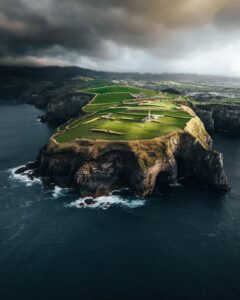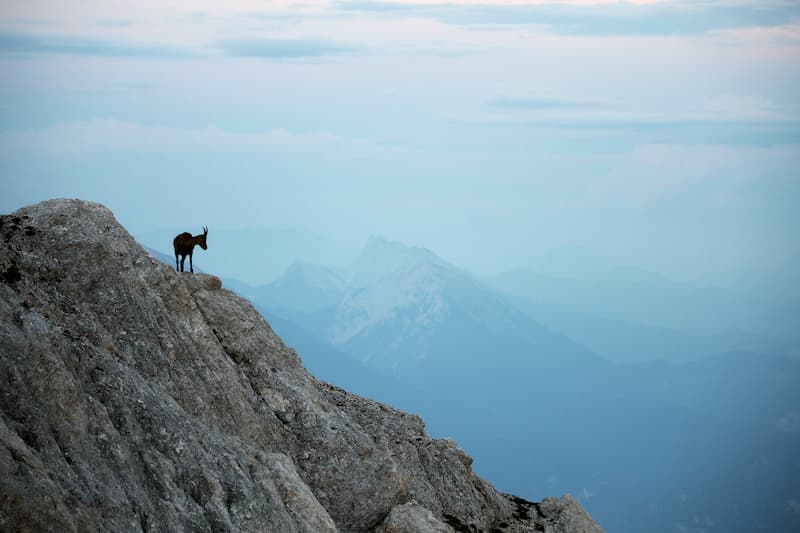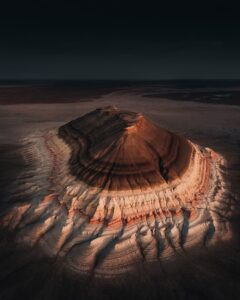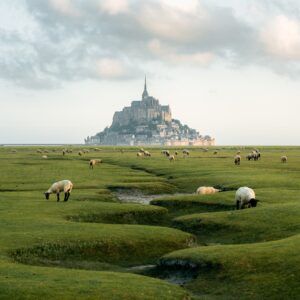
Photo tour in Azores, Portugal
Join us in the Azores for a unique photo tour, where you’ll elevate your creative skills with expert guidance from Ronald Soethje, Bruno Ázera, and Nomadict.
In 2015, Chris traveled through South-East Asia for six months. When he came back, he decided to make photography his profession. Now, as a successful full-time creator, he shares his top lessons and experiences in this article! Chris provides valuable tips about his creative process and showcases some of his favorite images.
My interest in photography was ignited during my childhood. During my teenage years, I was highly active in the Freerunning community, which involves running and gymnastics in an urban setting. It was during this time that I began to capture photos of my friends performing incredible stunts. This is how I got into photography. While I still find action sports appealing, human connection and natural surroundings have started to play a bigger role. The more I had the option to travel to interesting places and meet new people, the more this feeling of awe, connection, and remoteness started to appeal. I am grateful to be able to experience both passions.
In 2015, I embarked on a six-month journey through South-East Asia. Being by myself and with a camera resulted in taking tons of photos in a variety of places and situations. I suppose that constantly taking photos for half a year made photography a habit. The prolonged and consistent practice during this time allowed me to improve my skills. After returning from this trip, I challenged myself to pursue photography for a living, and up to today I am still doing the same thing.
While planning ahead is an important aspect, it’s good to keep in mind that things will always go differently than expected. Being flexible and adapting to unforeseen circumstances is therefore probably even more important. It’s not difficult to capture a great photo when all circumstances align, but it’s when faced with challenging weather conditions, equipment malfunctions, or unexpected time constraints that prior experiences can make a difference.
Networking doesn’t have to be as daunting as it may seem. Initially, I had pictured people meeting in conference rooms and awkwardly promoting themselves to others while everyone else does the same. However, I’ve discovered that simply connecting with people, showing genuine interest in them, and collaborating whenever possible is a more effective approach. Networking is basically about making friends and being yourself. It was a relief to realize this.
Instead of attempting to be hired for work that you haven’t even done for yourself yet, begin by creating the work that you wish to be hired for. This way clients know what you are able to do (and have an easier time hiring you) and you will feel more comfortable with the tasks ahead.
Many situations and experiences throughout the years have led to those lessons. A little less technical but as important, traveling has given me amazing insights too. It is difficult to compare the vastness of the outdoors. How can one compare the majesty of rugged mountain peaks to a unique cultural experience or the dampness of a rainforest? One particular moment stands out in my mind: I was traveling through Myanmar on my personal backpacking trip without any specific goals except for photographing what I witnessed and experience as much as possible. I ended up at a local celebration in a small village. The occasion was the slaughter of a cow, and food was being divided between the inhabitants. As they enjoyed their homemade rice wine, it didn’t take long before everyone was dancing. Despite the language barrier, I joined in on the dancing and celebration, realizing the importance of being present as a human first, and as a photographer second. The connection at that moment felt genuine, I was welcomed by the people, and the whole experience was so much different than when I had only taken photos and tried to maximize the result. An experience I won’t forget.
One of my photos that showcases a great atmosphere was captured early in the morning in the Julian Alps of Slovenia. With images like this one, I depend partly on planning and partly on luck. However, when you do enough planning the luck aspect will definitely play less of a role. Our plan was to climb Slovenia’s tallest mountain, Triglav, and we arrived at a nearby hut the afternoon before this photo was taken. Unfortunately, the light was poor, there were too many people around, and the conditions just didn’t align. I considered the sun’s position and decided that a sunrise shot would be ideal: partly sunny, partly cloudy, and facing the right direction. We began our hike in the dark with no one else around. However, the morning turned out to be cloudier than expected. I learned from experiences in the past that the cloud layer might change quickly, especially in the mountains. This was exactly what happened right after we summited and the conditions aligned. Hoping for the best, but preparing for everything, right?
To begin with, it’s essential to expose the subject properly. People usually say ‘expose for the highlights’, which means that you don’t have any overexposed parts in the image, but the foreground can become fairly dark. If you first decide what the main subject and area of attention will be for your photo you can expose for that part and guide the viewer in the right direction. For example in a portrait it might be better to expose for the skin and have the sky slightly overexposed, than leaving the subject underexposed with a correct sky exposure. Same principle goes for a landscape photo.
Layering and leading lines are also crucial to creating a captivating landscape image. Mountains are gorgeous, but sometimes we need more than just the subject. Including additional elements such as lines and layers can add depth and dynamism to the photo.

Some people use wideangle lenses for landscapes to show more of the foreground and create that depth. However, I prefer to use a telelens in quite a lot of compositions to increase the compression and make massive landscapes seem even more massive. Zooming in to focus on details and light differences makes a photo more interesting to me.
Finally, I look for something happening in the photo, such as a person to show scale, an animal in its natural habitat, or the interplay of light and nature. Having a specific subject in a landscape is something that makes a photo stand out to me.
Located slightly inland from the South Coast of Iceland there is the Haífoss waterfall. Currently the waterfall is getting more and more attention, since it is simply gorgeous and one of the tallest waterfalls in Iceland. I captured this image during a photography workshop that I hosted. When you arrive at the site, you are at the top of the waterfall. There is a path that leads to the bottom of the cliff, which offers an entirely different perspective of the waterfall.
One of the advantages of photographing Haífoss is that tiny water droplets from the waterfall combine with sunlight to create rainbows frequently. Therefore, the steps to take this picture wer fairly easy. First I tried finding the perfect composition. For this particular image, I searched for a quiet puddle of water to capture a reflection of the waterfall. Then, it was all about setting the camera’s parameters and waiting patiently for that perfect moment to occur.
I place great importance on maintaining color consistency throughout a series of photographs, accentuating warm and rich tones to enhance the existing image. For the image below, I cropped it to a preferred composition, adjusted the white balance and exposure to a more or less neutral look, and brought out the warm colors while keeping the blues subdued.
To ensure sharpness was only applied to the intended areas, I selectively applied it. Additionally, I brightened and darkened specific regions to draw more, or less attention to it. When determining which elements of the image to emphasize, I tried not to exaggerate and at the same time keep it balanced. For example, in this case, the rainbow was a prominent feature, but editing the colors too much could result in unnatural color shifts and banding.
When selecting locations for my workshops, I tend to avoid so-called “photo locations” and instead go to places where participants have a chance to find their own compositions, instead of the one everyone knows from exactly that one viewing platform. Next to choosing a good location, the timing of visiting is equally as important: using the middle of the day for traveling while shooting early in the morning and later in the day is usually the daily routine.
During my workshops, a typical day involves photography, hiking, post-processing, and traveling. We make use of the best light during the early mornings and late afternoons/evenings when the colors are vibrant and the light is soft. The day usually starts with optional assignments that participants can focus on throughout the day, and we discuss what potential photographic opportunities we will have.
Photography is not the only aspect we cover in my workshops. We hike to experience the landscape and to get to the more unique places – So not only driving to places and photographing next to the car, but exploring and doing that bit extra effort to find interesting locations and perspectives.
During the middle of the day or late in the evening, we usually have a collaborative editing session, working on our images, exchanging opinions, and learning from each other. Of course, if the Northern Lights emerge during our Iceland workshops, we drop everything and shoot as much as possible.
We mostly visit places away from the crowds. We might go to a few well-known locations, but the workshops shine most when we head into the more remote areas to look for our own locations, instead of only capturing what we already know from the internet.
Photographing a mountaineering course for an Alpine Association was a pivotal moment for me as it made me realize my heart is in the mountains. Everything about capturing these activities in such a beautiful rugged environment appealed to me. Not only capturing the people during their climbs, interactions and happy moments, but also taking part in it myself. The more effortful the journey, the better. I want to experience, feel, and be part of the process. Not only does it – hopefully – let me capture better images, but it makes me feel alive! Following this project, I shifted my focus to outdoor photography, spending as much time in the mountains as possible. This is just one of the projects which contributed to the path I am currently walking; I think it is the combination of all sorts of assignments that expand my network and let me improve my skill set in different types of photography and post-processing.
Often, the process of finding a composition, putting in the effort to get a shot, and processing it afterward is more fulfilling than having the final image itself. Once it’s out there, it’s easy to compare it to others and notice things that I don’t like or would have done differently. In short, the process leading up to the final result is what is closest to my heart! Nonetheless, I am proud of and happy with certain photos. You can find one of them below.
This photo was taken during my trip to Switzerland. With views on the Aletsch glacier, it was a nice effort to create this photo. I had a tripod with me and took at least 10 tries to create this self portrait. I didn’t have wifi on my camera back then so I was running back and forth on a ridge to reach the right spot before the self-timer went off. Eventually, I succeeded with the sun in the perfect position. The photo is a panorama made up of 12 individual photos; I was only present in one frame and I created the other 11 photos after creating the center frame.
In my view, photography is more of a means to a goal than the goal itself. It enables me to go on adventures, push a bit further than I otherwise would, and build connections with people I otherwise wouldn’t have met. As long as I can continue down that path I would be grateful.
Expanding my photography workshops to new locations is one of my objectives. While I have been leading trips to Iceland for several years with pleasure, taking people to other places I fell in love with would be a great progression. The good news is that I have some really cool workshop ideas in the pipeline which will be online not too long from now!
Moreover, I would love to photograph more meaningful stories in interesting places. To achieve this, I will give myself the same advice I received when I started:
Create the type of work you aspire to be hired for, and the right clients will eventually find you for that. Don’t simply wait for your dream assignment to come along, work toward it!

Join us in the Azores for a unique photo tour, where you’ll elevate your creative skills with expert guidance from Ronald Soethje, Bruno Ázera, and Nomadict.

In this article, Forest shares how years of chasing scale, silence, and raw landscapes shaped his approach to photography, from the deserts of Kazakhstan to the volcanic ridges of Iceland. He talks about how he uses light, texture, and vast negative space to create images that feel both intimate and overwhelming.

Simon shares the journey behind his photography, from early inspirations to field techniques, editing, and the story of the winning shot that shaped his path.

In this article, Miro shares how his love for cinematic music evolved into a deep passion for photography and how he uses light, color, and atmosphere to turn the streets of Prague into living film scenes.

In this article, Stefanie reveals how her background in physics sparked her passion for astrophotography and how she blends science with creativity to capture the beauty of the night sky. Readers will discover her approach to color, contrast, and editing, as well as her aurora photography workflow.

Spanish photographer Yhabril captures the profound connection between humans and the mountains that shaped him. Growing up in the Pyrenees, his work bridges outdoor sports, landscapes, and celestial scenes — often blending athletes, moonlight, and wilderness into striking visual stories.

In this article, Ariane shares how photography helped her navigate personal challenges, connect authentically with people and animals, and develop a philosophy rooted in empathy and artistic freedom. Readers will also discover her ethical approach to wildlife photography and her trusted equipment for both camouflage techniques and cameras.

Discover how to photograph Dutch tulip fields in their most magical light. From choosing the right gear and lenses to mastering composition, color, and aerial perspectives, this guide shares creative techniques to capture the beauty of the Netherlands’ tulips. Learn how light, color grading, and proportion bring emotion into every frame.
